Its designations as both an International Biosphere Reserve and UNESCO World Heritage Site indicate how extraordinary Hawai‘i Volcanoes National Park is on a global scale. It’s truly one of the most remarkable national parks in the United States, if not the world.
Home to the most active and the largest active volcanoes on the planet, Hawai‘i Volcanoes National Park is a place of constant change.
Its Kīlauea Volcano, the centerpiece of the park’s touristy area, has erupted non-stop since 1983. Mighty Mauna Loa, on the other hand, has also left its marks on the Big Island landscape in the form of massive lava flows.
Throw into the mix amazing rain forest scenery, lush meadows, volcanic gas vents, lava tubes and abundant native fauna, and you’ve got an exceptionally—perhaps even surprisingly—diverse national park in Hawaii.
Below, you’ll find a bunch of fun things to see and do in Hawai‘i Volcanoes National Park.
This blog post about what to see and do in Hawai‘i Volcanoes National Park contains affiliate links. You can read more about our Terms of Use / Disclosure here.
Contents
- Top 15 Things to Do in Hawai‘i Volcanoes National Park
- 1. Stroll Through a Cinder Landscape on the Devastation and Uēaloha (Byron Ledge) Trails
- 2. Try to Spot Native Hawaiian Animals at Kīpukapuaulu
- 3. Picnic in a Historic Farming Landscape at the Kahuku Unit
- 4. See the Puʻuloa Petroglyphs
- 5. Walk Through Volcanic Gases at Sulphur Banks
- 6. Watch the Sunrise From the Western Crater Rim Trail
- 7. Enjoy Volcano Rain Forest Scenery on the Halema‘uma‘u Trail
- 8. Explore the Otherworldly Kaʻū Desert
- 9. Have Lunch With a View at Volcano House
- 10. Spend Some Time on Mauna Loa, the Largest Active Volcano on Earth
- 11. Experience the Extraordinary Nāhuku (Thurston Lava Tube)
- 12. Drive the Chain of Craters Road
- 13. Hike the Kīlauea Iki Loop
- 14. Watch Kīlauea Erupt
- 15. Stay at the Volcano Teapot Cottage
- Accommodation Near Hawai‘i Volcanoes National Park
- Highlights of Other National Parks
Top 15 Things to Do in Hawai‘i Volcanoes National Park
From strolls along the Kīlauea Caldera rim to rain forest walks and volcanic desert hikes, there are plenty of trails at Hawai‘i Volcanoes to explore. Hiking is absolutely one of the top Hawai‘i Volcanoes National Park activities, allowing you to experience these marvelous landscapes up-close.
Other popular things to do include bird watching, scenic drives, picnicking, viewing the sunrise and enjoying lunch or dinner with a spectacular view
But above all, what attracts many, if not most, people to Hawai‘i Volcanoes National Park is the opportunity to watch a volcanic eruption live, right in front of you.
1. Stroll Through a Cinder Landscape on the Devastation and Uēaloha (Byron Ledge) Trails
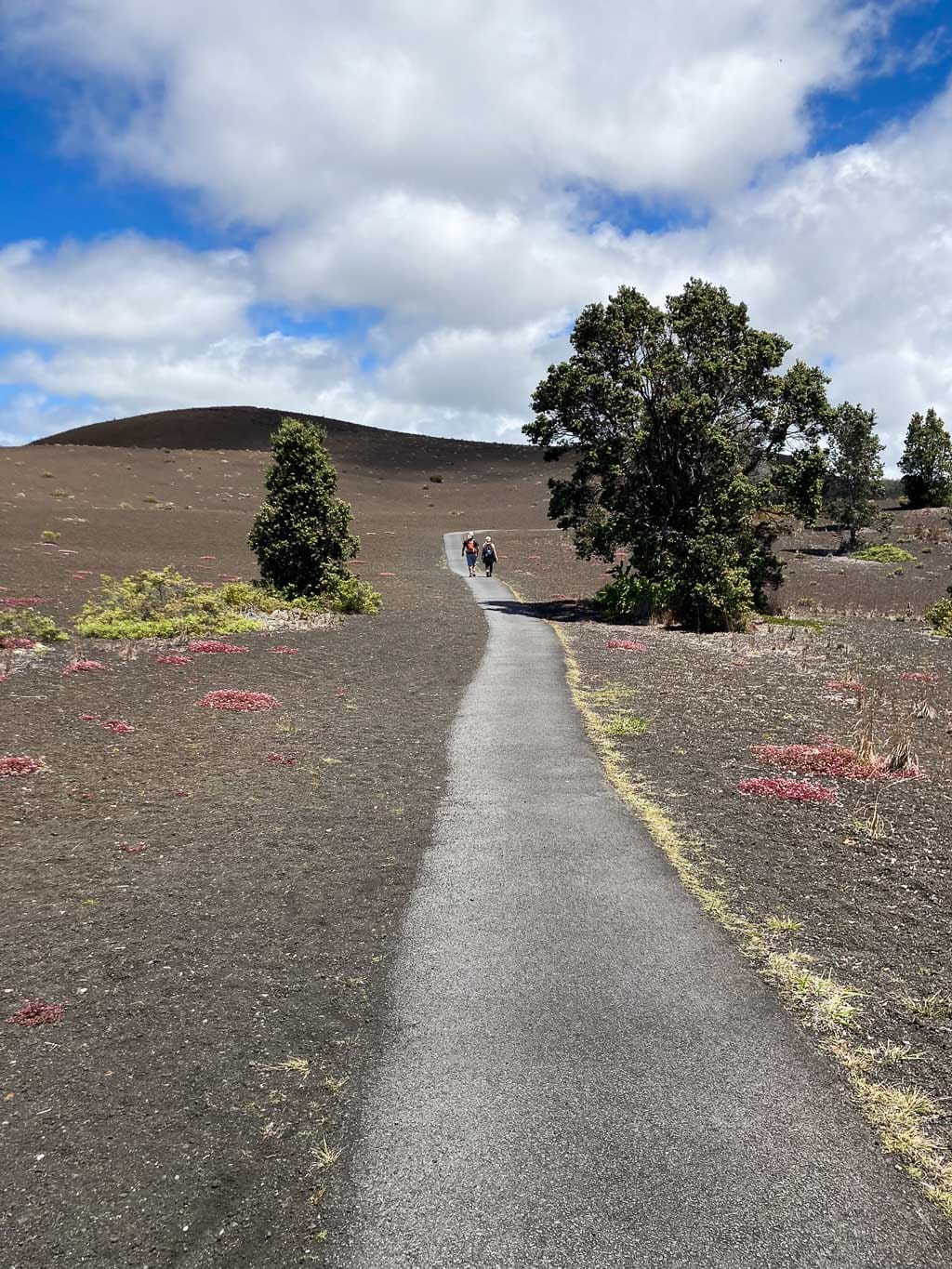
For an easy introduction to the destructive power of a Hawaiian volcano, there’s no better trail than the Devastation Trail.
Park your car at the Pu‘upua‘i Overlook parking area and explore a landscape that’s recovering from the Kīlauea Iki eruption of 1959, whose lava fountains covered the area in a thick layer of cinders.
This paved and wheelchair-accessible path runs through this impressive cinder landscape.
Dotted with new vegetation, including Hawaii’s iconic ohi‘a trees, it shows how a landscape slowly recover after a volcanic eruption.
You’ll walk the south side of the imposing Pu‘upua‘i Cinder Cone, on the other side of which is the spectacular Kīlauea Iki Crater. More about that one later on in this overview of things to do at Hawai‘i Volcanoes National Park.
The Devastation Trail is only 1 mile out and back, but you could make it a longer hike by continuing on the Uēaloha (Byron Ledge) Trail. Combined, those two trails are a 2.1-mile roundtrip.
For an even longer day hike, it’s also possible to link these trails up with the Kīlauea Iki Loop Trail.
2. Try to Spot Native Hawaiian Animals at Kīpukapuaulu
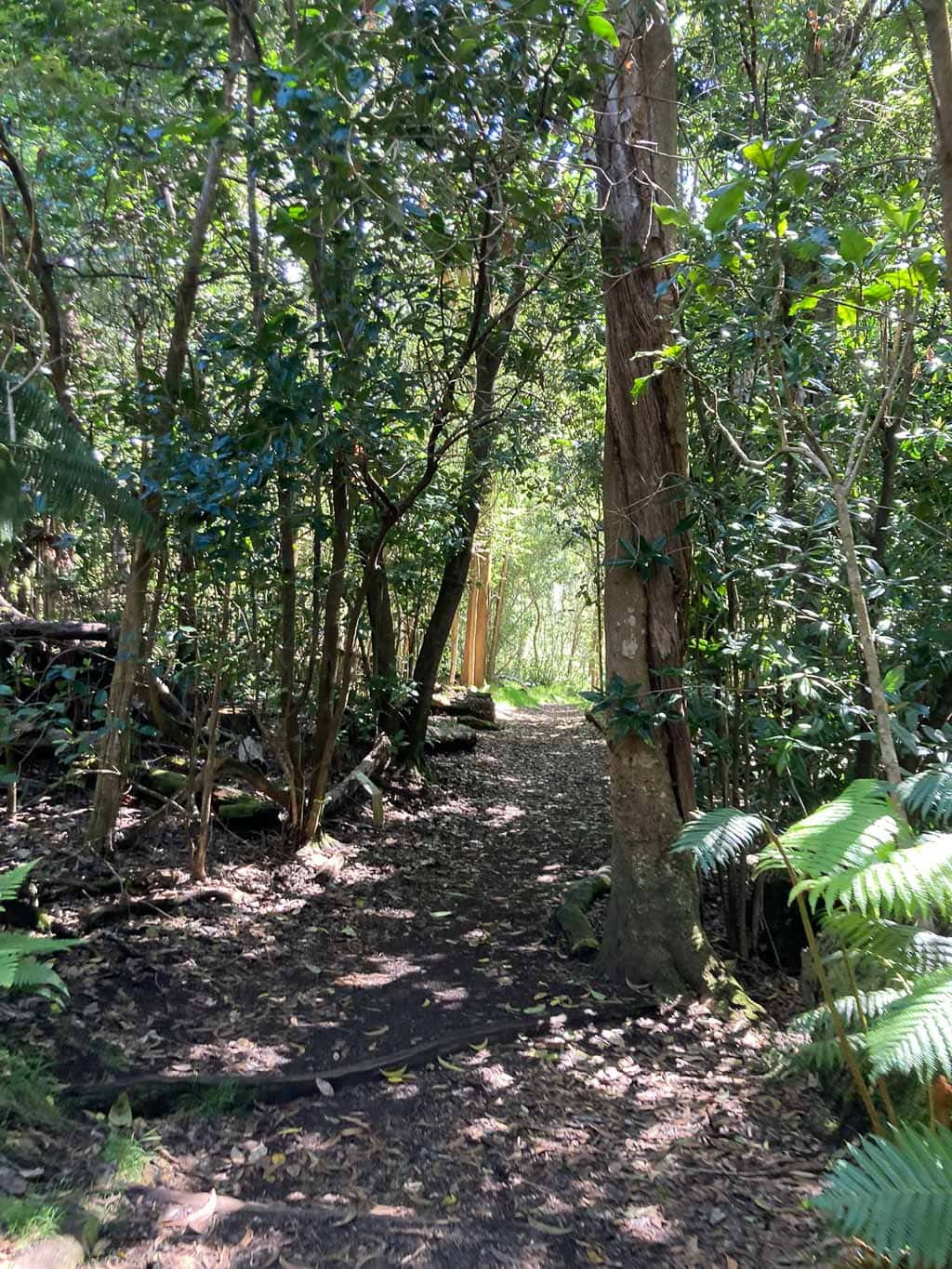
An enjoyable stroll in a regenerating Hawaiian forest, Kīpukapuaulu offers an insight into the struggle for survival of many native Hawaiian plants and animals.
This is an easy 1.2-mile loop hike takes you through a kīpuka, an area of ancient vegetation that escaped more recent lava flows. They’re effectively an “island” in a “sea” of lava, as the National Park Service explains here.
In the case of Kīpukapuaulu, the lava flowed down from the summit of mighty Mauna Loa above. On this scenic forest hike, you can learn about Hawaii’s native trees, plants, birds and insects, and the enormous threats posed by invasive species.
Besides the word kīpuka, the name of this area consists of two other Hawaiian words. Pua means flower, while ulu means growing. So essentially, Kīpukapuaulu can be translated as “island of growing flowers in a sea of lava.”
It’s a fascinating hike and a wonderful stop along the less-explored Mauna Loa Road.
Consider hiking this short Hawai‘i Volcanoes trail in the morning for the best chances to see unique Hawaiian fauna like butterflies, honeycreepers and other birds.
3. Picnic in a Historic Farming Landscape at the Kahuku Unit
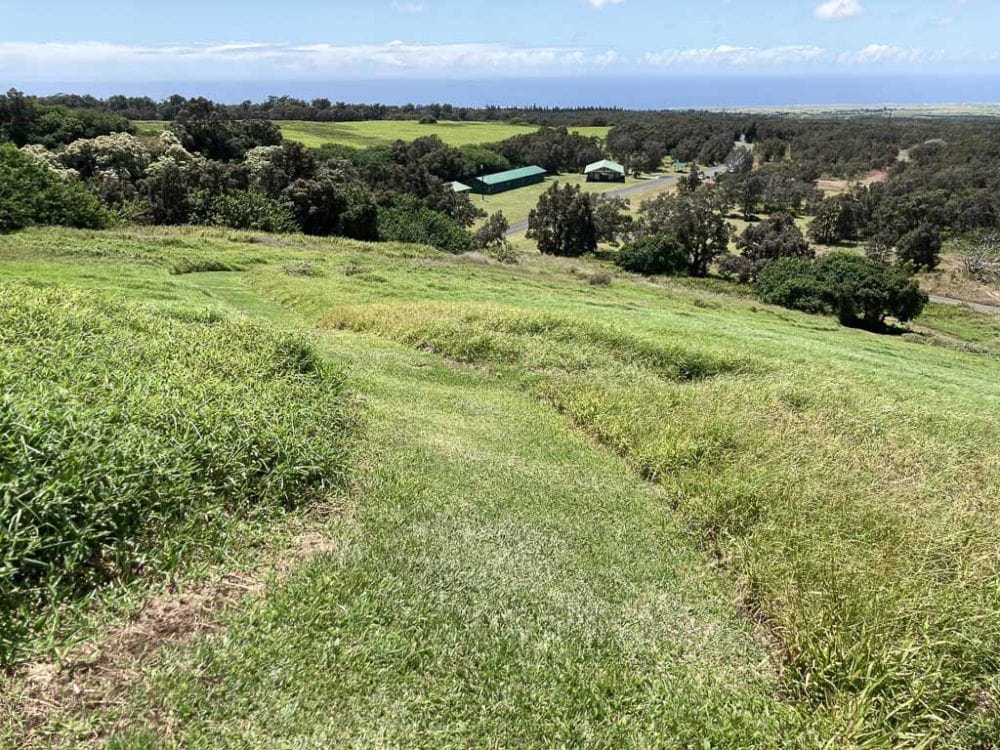
A 116,000-acre landscape of rolling hills, green meadows, groves of trees and cinder cones, the Kahuku Unit was added to Hawai‘i Volcanoes National Park in 2003. This addition effectively doubled the park’s size.
Despite the area’s fascinating history—it was once home to the Kahuku Ranch, one of Hawaii’s biggest cattle ranches—and scenic beauty, many visitors skip it. Don’t be one of them!
Even if you just pop into the Kahuku Unit for a quick visit on your way to Kona, it’s worth the stop.
And I strongly recommend doing a short hike to experience this entirely different part of Hawai‘i Volcanoes National Park.
There are various trails to choose from, but the short Pu‘u o Lokuana Cinder Cone Loop is arguably the nicest. This wonderful loop trail begins at the Visitor Contact Station near the start of the Kahuku Road.
It quickly climbs the grassy slopes of the Pu‘u o Lokuana Cinder Cone, its summit treating you to a stunning panorama of verdant scenery. You can clearly see the Pacific Ocean from here, too.
Additionally, the Pu‘u o Lokuana Cinder Cone is special for its unusual red rocks. You can walk into the crater and see where Native Hawaiians used to mine chunks and pieces of rock.
Next to the parking area, an expansive lawn dotted with tables makes for a wonderful place to enjoy a picnic lunch after your hike.
4. See the Puʻuloa Petroglyphs
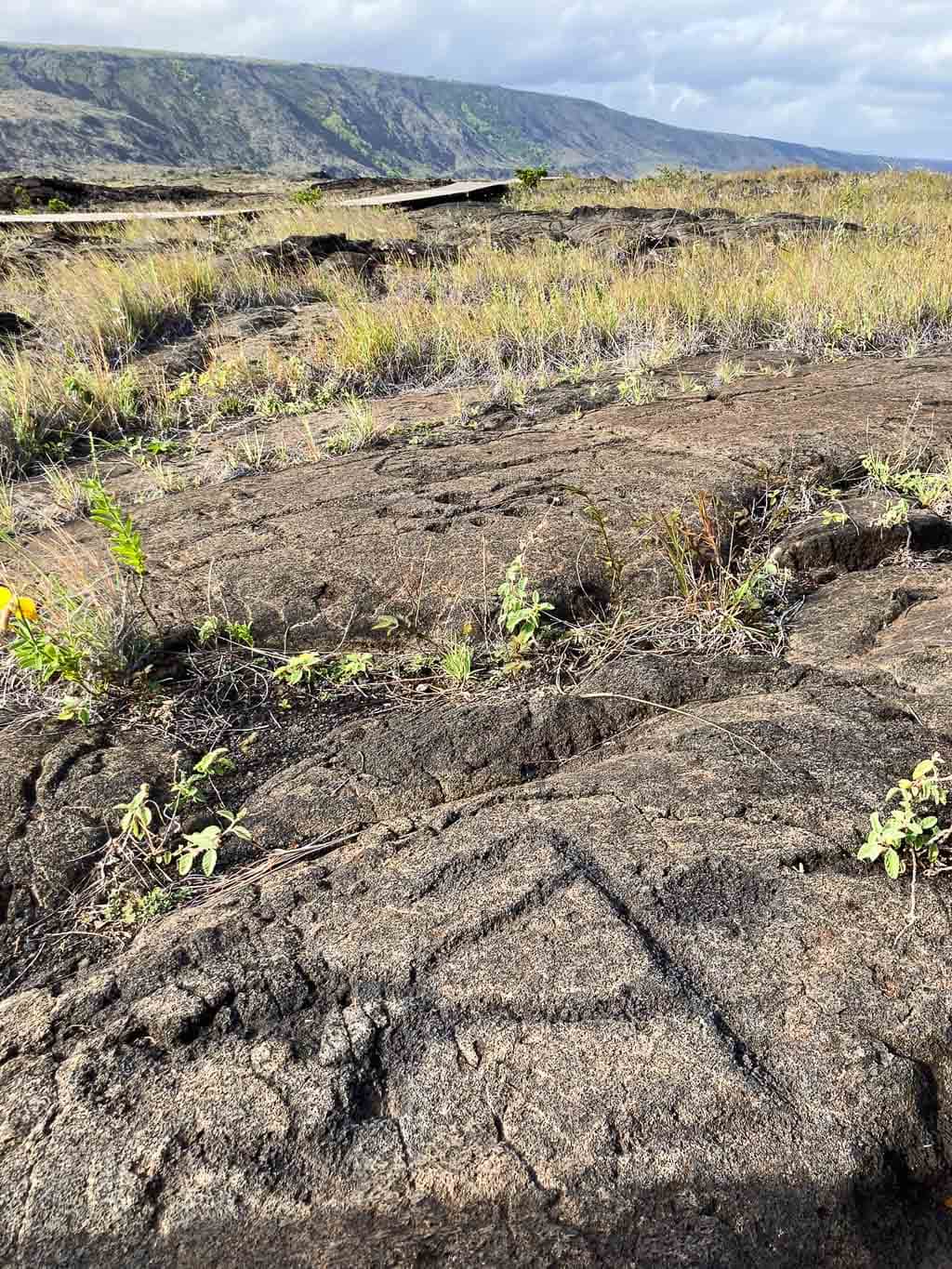
On this trail on the Chain of Craters Road (see below), you can “walk in the footsteps of the kūpuna (elders) to Puʻuloa (hill of long life), a sacred and awe-inspiring gallery of kiʻi pōhaku (images carved in stone).”
The Puʻuloa Petroglyphs Trail is one of the main Native Hawaiian heritage sites in Hawai‘i Volcanoes National Park, encompassing the largest field of petroglyphs in Hawaii.
Sprawling across a large area of 500-to-550-year-old lava, this site contains no fewer than 23,000 petroglyphs. Dozens upon dozens of those are visible from a boardwalk at the end of the trail.
This is a great place to get a better understanding of the life, beliefs and customs of the Native Hawaiian people.
Most of the petroglyphs you can see here are cup-like carvings, known as poho, which cradled the umbilical cord, or piko, of newborn babies. This practice was done in the hopes the child would enjoy a long and prosperous life.
Other petroglyphs at Puʻuloa are circles, canoe sails, cryptic motifs, straight lines and anthropomorphic figures.
5. Walk Through Volcanic Gases at Sulphur Banks
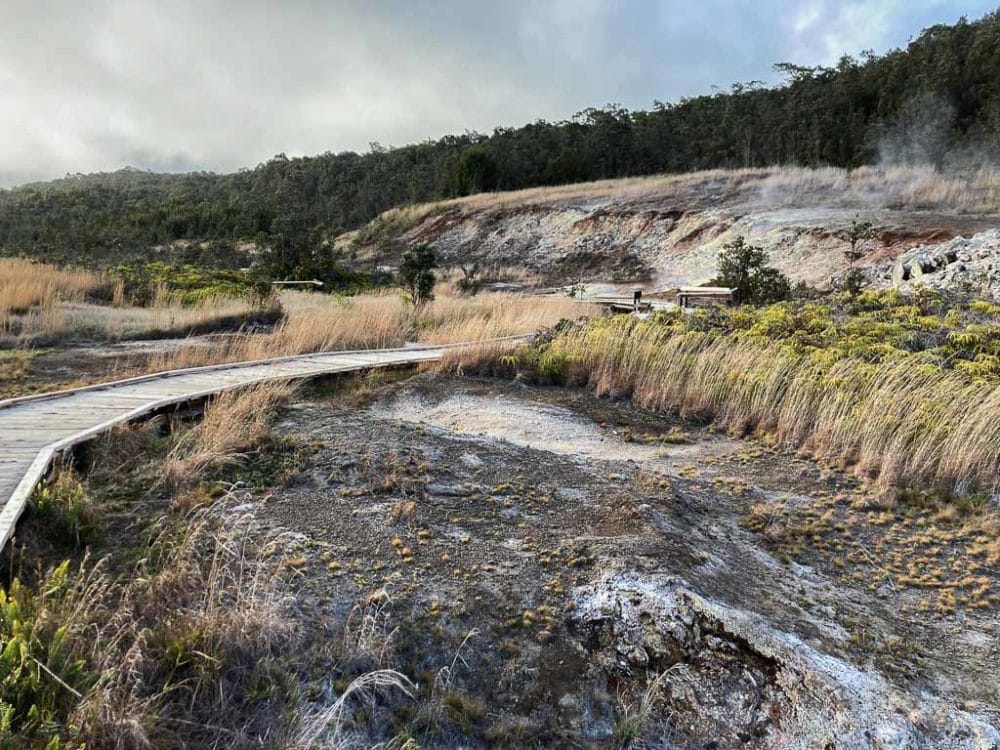
One of the top attractions at the Kīlauea Caldera is the Ha‘akulamanu (Sulphur Banks) Trail.
Known as Ha‘akulamanu by Native Hawaiians, the Sulphur Banks release volcanic gases from deep within the Earth.
Contrary to the nearby Steam Vents, which emit steam created from water seeping down through the soil and are also worth visiting, these gases originate much, much deeper.
The volcanic gases released at Sulphur Banks contain lots of carbon dioxide, sulfur dioxide and hydrogen sulfide. The latter is most recognizable because it smells like rotten eggs.
Besides watching the actual volcano erupt, the Ha‘akulamanu (Sulphur Banks) Trail is the easiest place to experience volcanic activity at Hawai‘i Volcanoes National Park.
Additionally, this fascinating hydrothermal area is also known for its colorful rocks, which are deposited as pure crystals by some sulfur gases. In another chemical process, sulfuric acid breaks down lava into clay, which in its turn is colored red by iron dioxide.
An easy boardwalk runs through the Sulphur Banks, offering hikers close-up views—and smells—of this fascinating area.
The total loop hike, which starts at the Kīlauea Visitor Center parking lot, is 1.2 miles.
6. Watch the Sunrise From the Western Crater Rim Trail
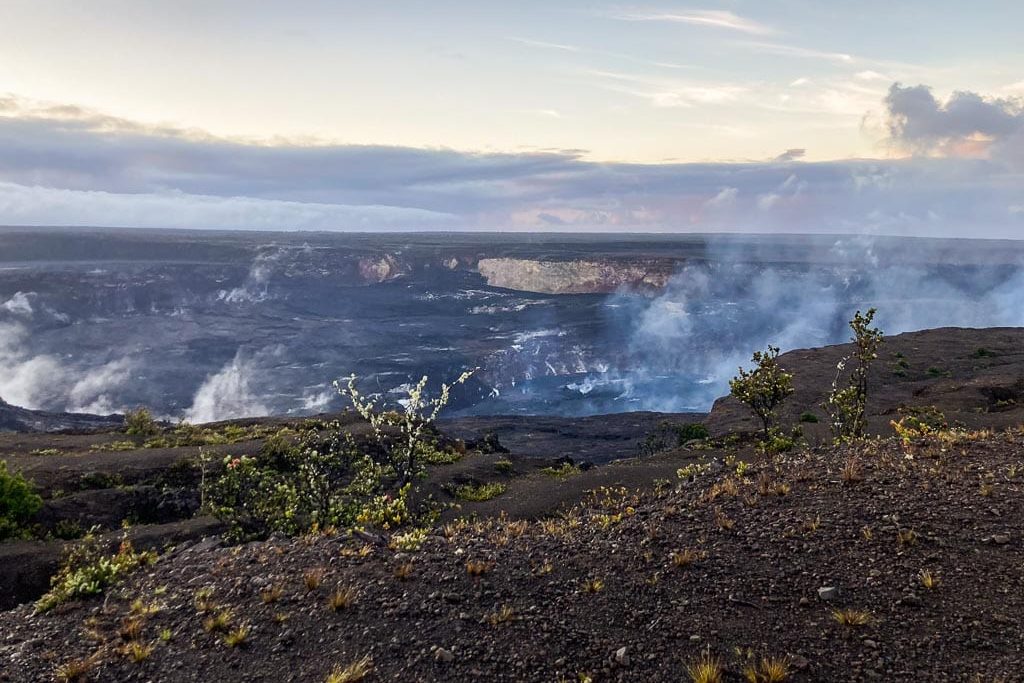
One of my favorite things to do when visiting a national park is getting up before sunrise. In popular parks like Grand Teton, Shenandoah, Glacier and also Hawai‘i Volcanoes, that’s the best time to enjoy the scenery without the crowds.
So, I highly recommend getting up early and driving to Uēkahuna, the western terminus of the Crater Rim Drive. The highest point on the Kīlauea Caldera rim, it’s also the western end of the Crater Rim Trail.
It’s as far west on the Kīlauea Caldera as you can get. The Hawai’i Volcanoes views to the east as the sun slowly rises above the crater in the morning are breathtaking.
Walk a section of the Crater Rim Trail from different vantage points above the enormous Kīlauea Caldera. Enjoy the view from the trail itself, but definitely also check out the Kīlauea Overlook.
7. Enjoy Volcano Rain Forest Scenery on the Halema‘uma‘u Trail
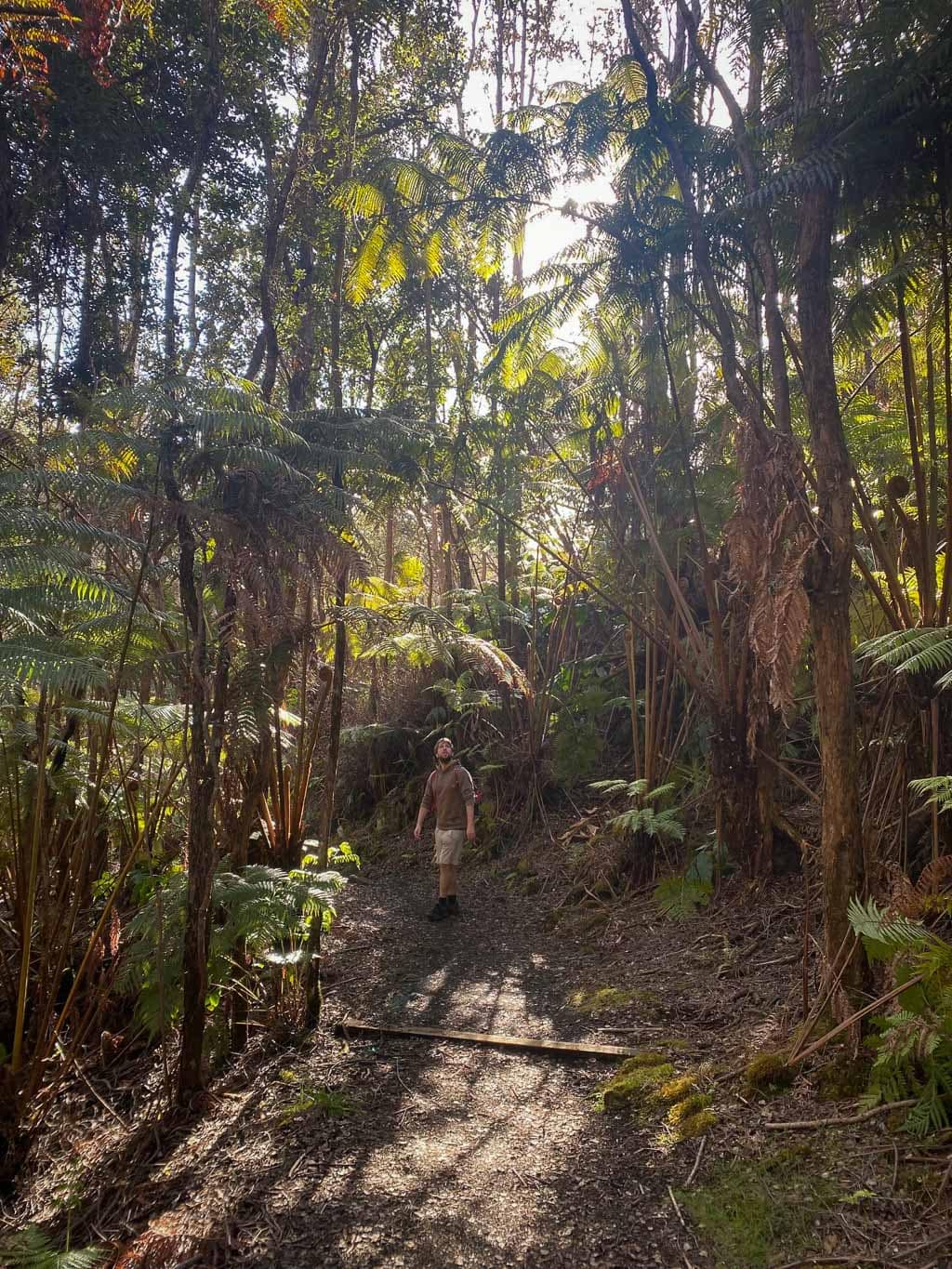
Starting from the historic Volcano House, the Halema‘uma‘u Trail has taken visitors into the Kīlauea Caldera since 1846. It’s one of the oldest tourist hiking trails in the park.
Although this awesome trail used to run all the way across the caldera floor to the rim of the Halema‘uma‘u Crater, it’s significantly shorter now.
Due to high levels of sulfur dioxide and the ongoing volatility of Halema‘uma‘u, it now ends at the Kīlauea Caldera floor. The current roundtrip hike is 1.6 miles.
Nevertheless, it’s still an absolutely beautiful hike, especially because it takes you through gorgeous rain forest scenery.
On the way from the rim to the caldera floor, a descend of 425 vertical feet, you’ll walk among and underneath towering tree ferns and lush tropical trees.
You’ll almost certainly hear a variety of Hawaiian birds chirping, singing and twittering. If you’re luck enough, you might spot a honeycreeper or other tropical bird.
Hiking through this section of Hawaiian rain forest is absolutely amazing. So is standing in the caldera of the world’s most active volcano. Combined, they make for a fantastic hike in—literally—the Kīlauea Caldera.
8. Explore the Otherworldly Kaʻū Desert
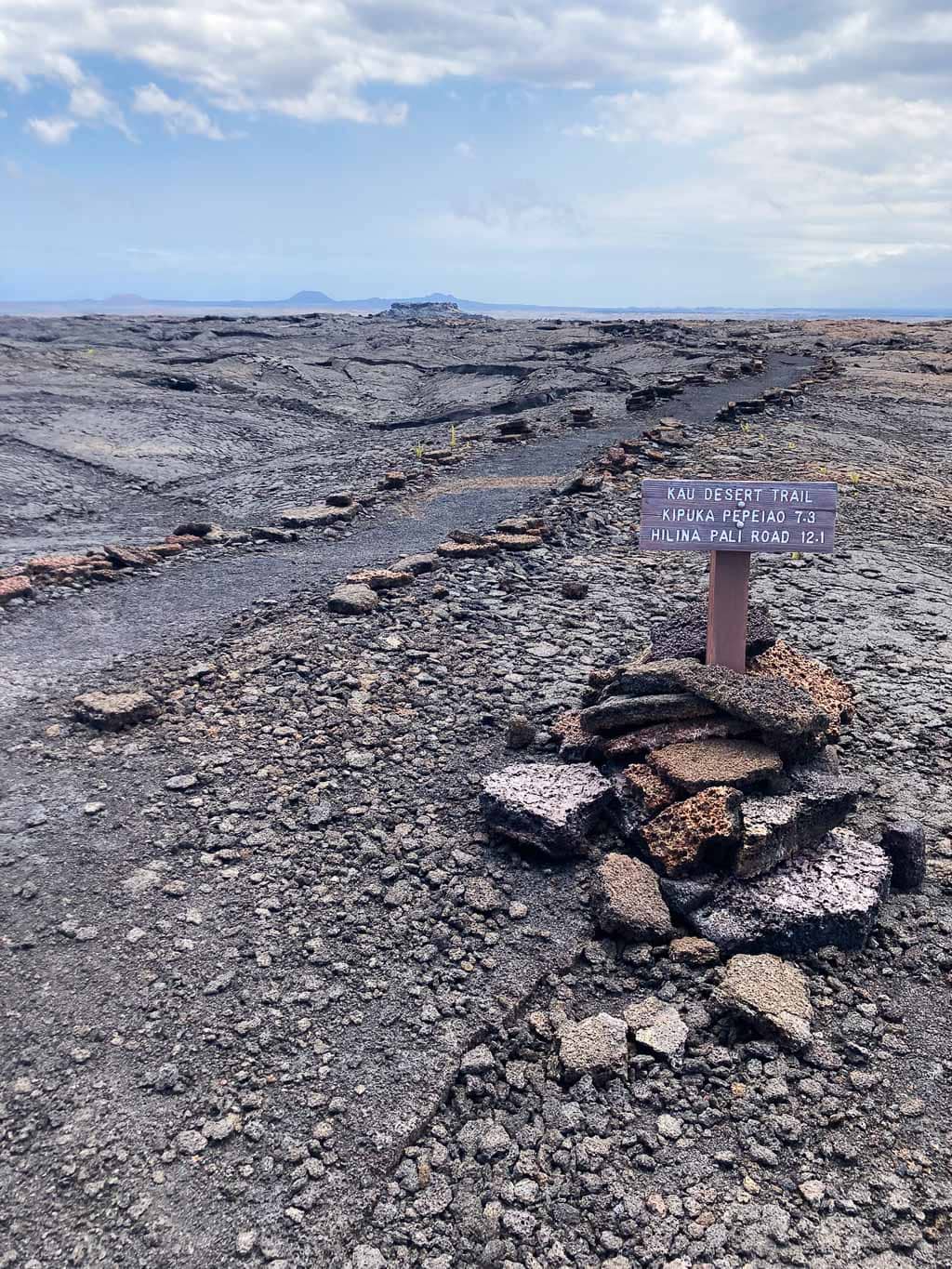
One of my personal favorite places in Hawai‘i Volcanoes National Park is not at the Kīlauea Caldera but along Highway 11, about 15 minutes west of Volcano Village.
A small parking area on the south side of the road marks the start of the Kaʻū Desert Trail. This relatively flat trail takes hikers deep into a remote, barren and often otherworldly-feeling lava landscape.
A major highlight along the way is the Footprints Shelter, which is 0.8 miles from the trailhead. This is where you can see the preserved footprints of Native Hawaiians who were surprised by a sudden eruption at the summit of Kīlauea in 1790.
Traveling on ancient trails, they were bombarded by ash, sand and gas from above, their footprints “a reminder that Hawaiians have beared witness to the geological drama of this island for centuries”, the National Park Service says.
Beyond the Footprints Shelter, the Kaʻū Desert Trail enters the sprawling and barren Maunaiki area.
You’ll walk across vast lava fields void of any vegetation whatsoever, a desolate and extremely exposed volcanic landscape on the southwest slope of Kīlauea.
The hike from the trailhead on Highway 11 to Maunaiki in the Kaʻū Desert is 1.8 miles one way, a 3.6-mile out-and-back trip.
At Maunaiki, however, you do have the option to extend your hike—the Kaʻū Desert Trail continues to the west, while the Maunaiki Trail winds its way southeast.
Note: Remember that this is an actual desert hike and you need to prepare. Except for the Footprints Shelter, some small trees and big rocks, there is very little to no shade anywhere on this trail. Bring sunscreen, a hat and plenty of water. Additionally, during windy conditions, the area’s ash and dust become airborne—glasses and a mask are useful then.
9. Have Lunch With a View at Volcano House
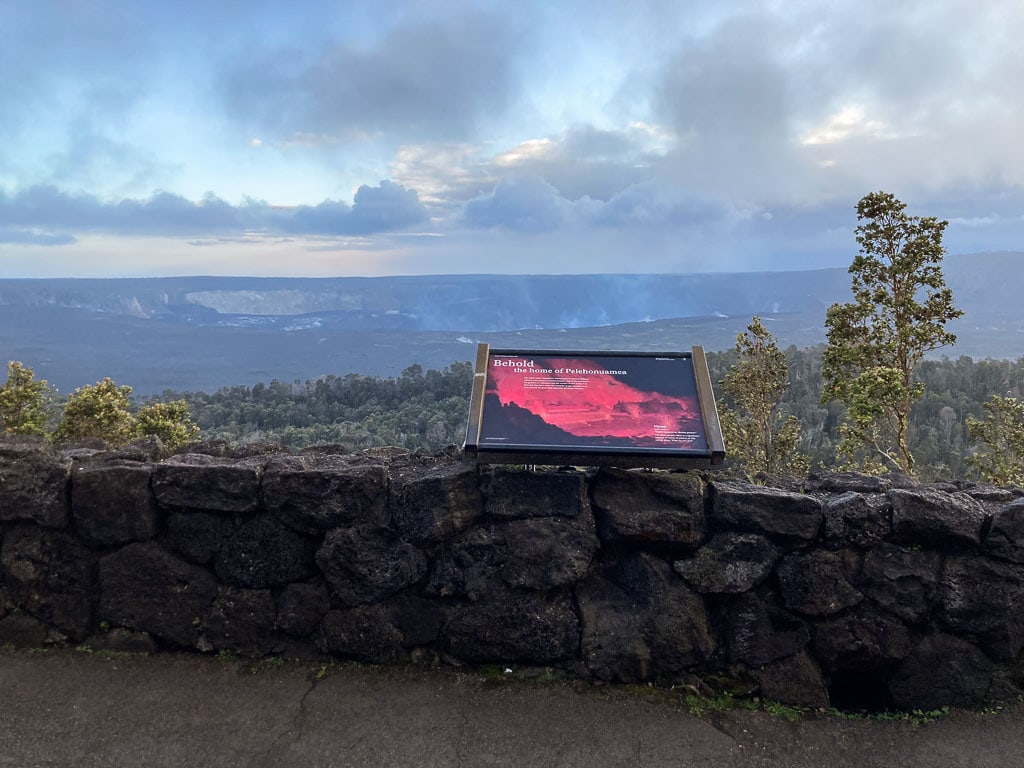
Its origins dating back to as early as 1846, well before Hawai‘i Volcanoes National Park itself was established, Volcano House is one of the oldest still-operating lodges in the national parks.
It’s also the only hotel at Hawai‘i Volcanoes, offering 33 historic guest rooms, a lounge, souvenir shops, snack bar and restaurant.
While a stay there is certainly memorable, you can also easily get a taste—pun totally intended—of the hotel’s historic significance by having lunch at one of its two eateries.
For the accommodation near Hawai‘i Volcanoes National Park I recommend instead, scroll down to number 15 in this list!
Uncle George’s Lounge is the more casual of Volcano House’s eating areas. It’s a great spot for lunch, a light afternoon snack or evening drink.
The Rim Restaurant, on the other hand, is more upscale, serving more elegant fare to the sound of live music by local musicians.
Both places are nice, though, and provide awesome views of the Halema’uma’u Crater. The Crater Rim Trail passes right by the windows outside. You can simply step inside for a bite after, or fuel up before, your hike.
10. Spend Some Time on Mauna Loa, the Largest Active Volcano on Earth
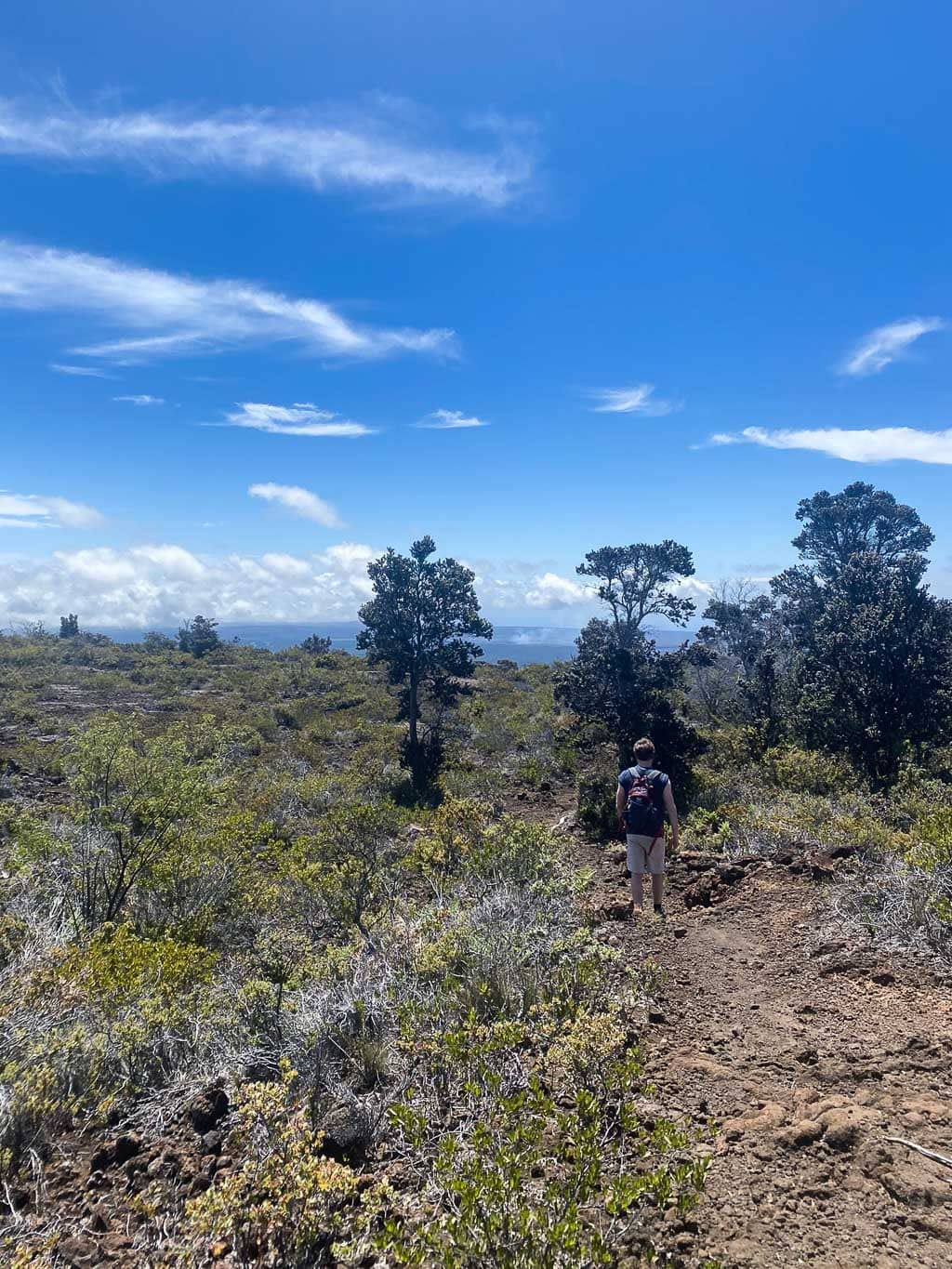
Besides walking in the caldera of the world’s most active volcano—see the Halema‘uma‘u Trail above—you can also walk on the largest active volcano on Earth at Hawai‘i Volcanoes National Park. How cool is that?
Drive the Mauna Loa Road to the Mauna Loa Lookout for a great view of the Kīlauea Caldera in the distance below.
This scenic road is 11.5 miles long and paved. It is, however, rather winding, occasionally bumpy and only has one lane, so drive the speed limit and be careful around bends.
The Mauna Loa Lookout is the highest point in Hawai‘i Volcanoes National Park accessible by car. It’s not even close to this massive mountain’s summit, though.
To get to the summit of Mauna Loa, you have to hike more than 19 miles on the Mauna Loa Trail, which starts at the lookout, and back again. It’s an extremely strenuous backpacking trip that takes 3-4 days.
For an easier, quicker and arguably more physically enjoyable Mauna Loa experience, you can simply hike a section of the Mauna Loa Trail.
11. Experience the Extraordinary Nāhuku (Thurston Lava Tube)
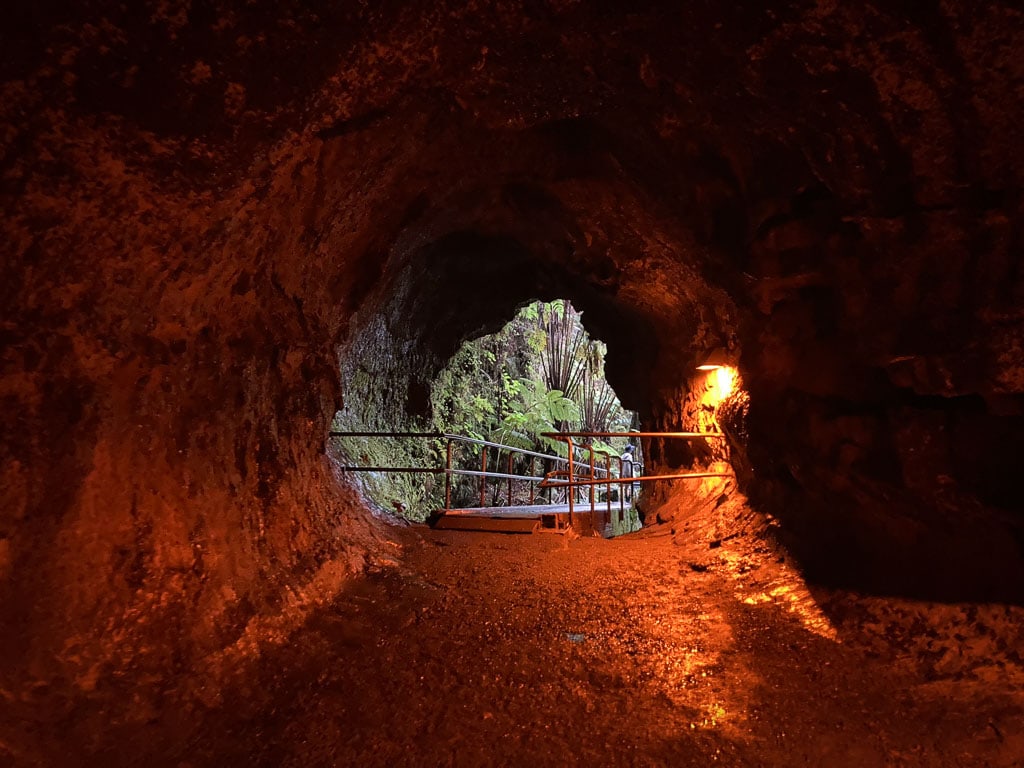
Easily one of the most-visited places in Hawai‘i Volcanoes National Park, Nāhuku (Thurston Lava Tube) is open 24/7 and spectacular at any time of the day or even, maybe especially, at night.
This amazing lava tube, a cylinder-shaped cave created 500 years ago by a river of lava, can be explored on a short 0.5 mile loop hike.
Before entering Nāhuku—the name means “the protuberances” in Hawaiian—the trail winds its way through a lush rain forest home to numerous native birds.
The lava tube itself is one of the star attractions at Hawai‘i Volcanoes, which will become clear to you when you (try to) visit it in the middle of the day.
The small parking lot is almost always full, so I recommend doing the Nāhuku loop hike early in the morning or late in the evening. For an unforgettable experience, grab a flashlight and explore the lava tube in the dark of night.
If the Nāhuku parking lot is full, you can also try finding a parking spot at the nearby, larger Kīlauea Iki Overlook parking lot. From there, it’s a 1.5-mile roundtrip hike.
Note: This isolated cave environment is home to its own ecosystem, which is fragile and easily destroyed. Please keep your hands to yourself and don’t touch the lava tube walls or any hanging roots.
12. Drive the Chain of Craters Road
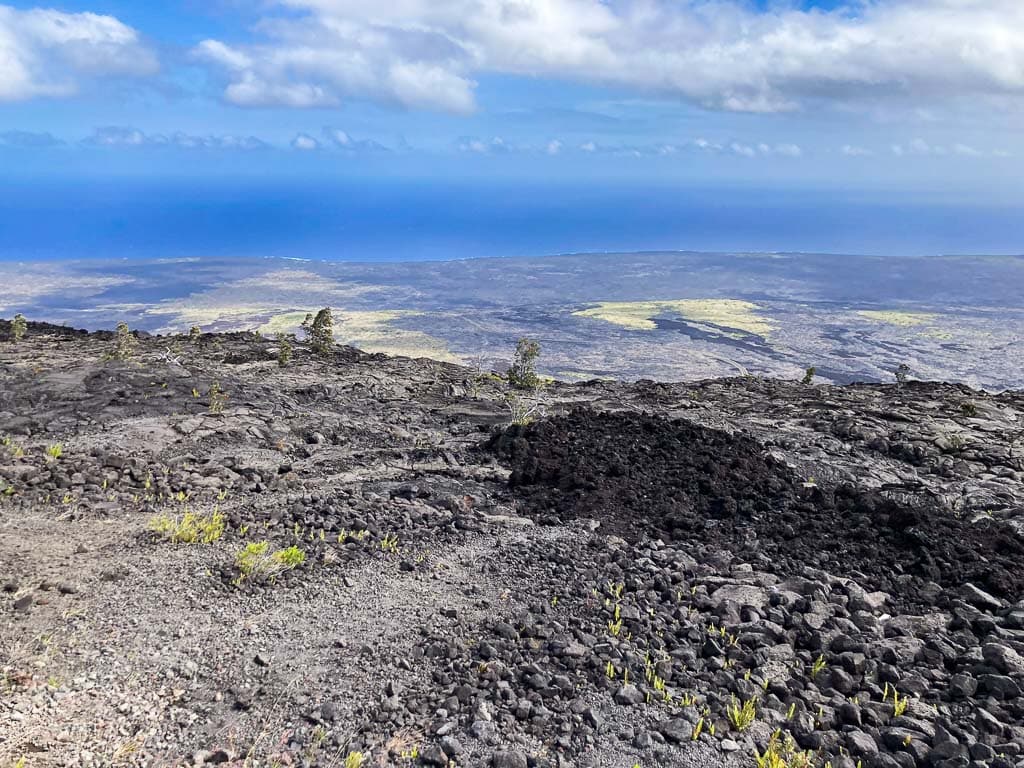
The longest of the three scenic drives in Hawai‘i Volcanoes National Park, the Chain of Craters Road has a long history of destruction, rerouting, rebuilding and reopening.
Formerly known as Crockett’s Trail, the first version of what is now the Chain of Craters Road was dedicated in 1928.
Partially buried several times by volcanic eruptions—most notably in 1969, 1972, 1989 and 1992—the road runs past a number of spectacular craters, historic sites, viewpoints and natural landmarks.
While there used to be a visitor center, campground, Native Hawaiian village site and even a black sand beach along the road, those are now all gone. Presently, there is no food, water or fuel along the Chain of Craters Road.
Running for 18.8 miles from the Kīlauea Caldera down to the coast, it’s a spectacular drive. The road ends near the iconic Hōlei Sea Arch, a lava rock arch extending into the Pacific Ocean.
Other major highlights along the way include the trail to the Maunaulu lava flows of 1969-1974, the panoramic Kealakomo Overlook and the partially buried remnants of the old Chain of Craters Road at the Alanui Kahiko pull-out.
The Puʻuloa Petroglyphs mentioned above are also on this scenic road.
13. Hike the Kīlauea Iki Loop
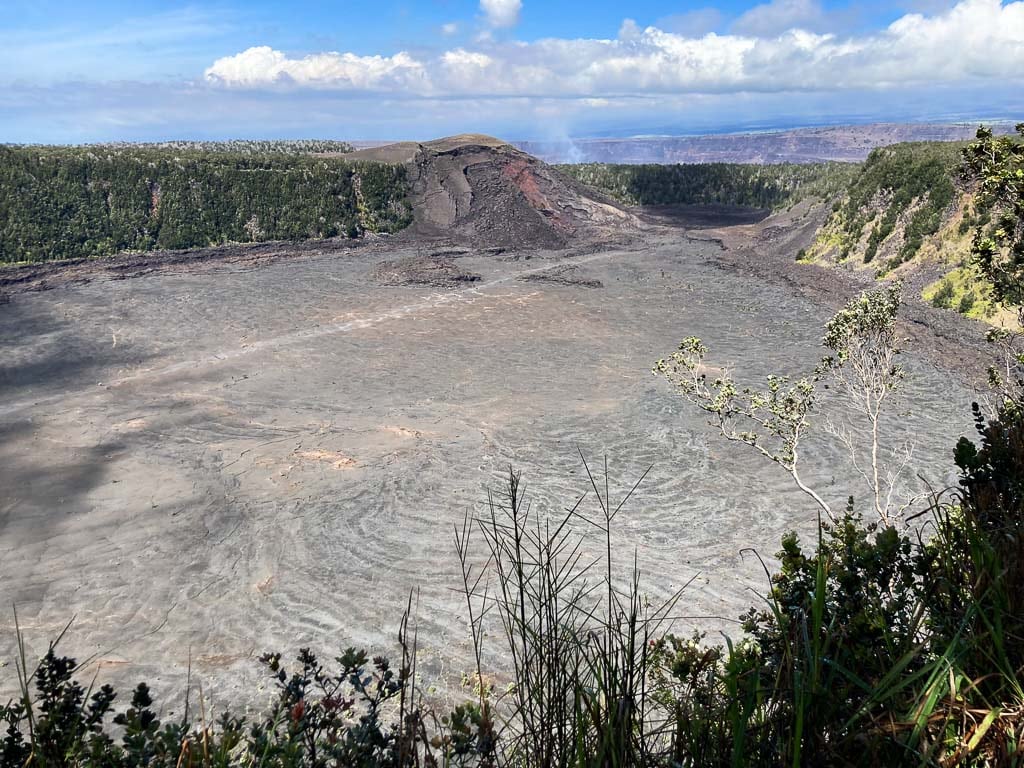
Hiking the Kīlauea Iki Crater Loop is without question one of the most popular things to do in Hawai‘i Volcanoes National Park.
This phenomenal hike includes everything that makes Hawai‘i Volcanoes National Park so special. There are sections of stunning rain forest, spectacular overlooks and a stretch that runs—literally—across a solidified lava lake.
The Kīlauea Iki Crater was filled with seething lava after a vent erupted below the Pu‘upua‘i Cinder Cone in 1959. The vent spewed lava thousands of feet into the air.
According to the National Park Service, it’s “considered by some to be the most spectacular eruption event of the 20th century.”
Nowadays, the lava is solid at the top, but still lingers in its red-hot molten state not all that deep below the trail.
You can hike the 3.3-mile Kīlauea Iki Crater Loop from either the Kīlauea Iki Overlook or Nāhuku (Thurston Lava Tube) parking lot, which are the shortest hiking options.
Longer loops can be created by combining the Kīlauea Iki Crater Loop with Nāhuku (Thurston Lava Tube) and the Devastation and Uēaloha (Byron Ledge) Trails.
Together, these four individual trails make for a superb 7-mile roundtrip hike. The trailhead for this longer day hike is at the Pu‘upua‘i Overlook parking lot.
Whichever loop or starting point you chose, you’ll be in for one of the most extraordinary day hikes in America’s national parks.
14. Watch Kīlauea Erupt
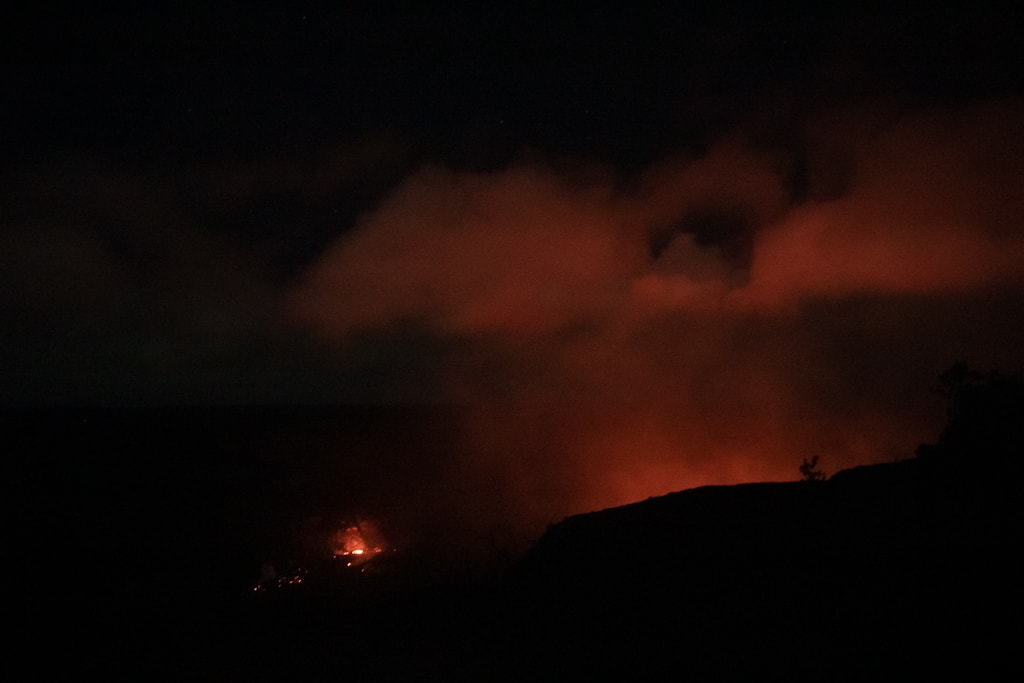
Although it requires some serious luck or short-term planning to be at Hawai‘i Volcanoes during actual active lava flows, you can still see a volcanic eruption live in action.
Kīlauea has been erupting continuously since 1983, an exceptionally long volcanic event with alternating periods of relatively quietness and more violent explosions.
Currently, you can see the Halemaʻumaʻu Crater eruption within the Kīlauea Caldera. This eruption, which, during the day, is mainly visible in the form of volcanic gases and steam, can be seen from the crater rim.
At night, however, the huge lava lake in the crater projects a red-orange glow into the dark night sky.
“The glow reflects onto the gas plume wafting out of the volcano, and to any clouds above the summit crater, Halemaʻumaʻu. Jagged crater walls are illuminated, showing the scars from the 2018 summit collapse,” the National Park Service says.
The best places to see the Kīlauea lava lake are the Keanakākoʻi Overlook, Uēkahuna and the Kīlauea Overlook.
Additionally, the volcanic gas and steam clouds are also visible from other places along the crater rim, including Volcano House.
Check this page for current Kīlauea Volcano eruption conditions and updates
15. Stay at the Volcano Teapot Cottage
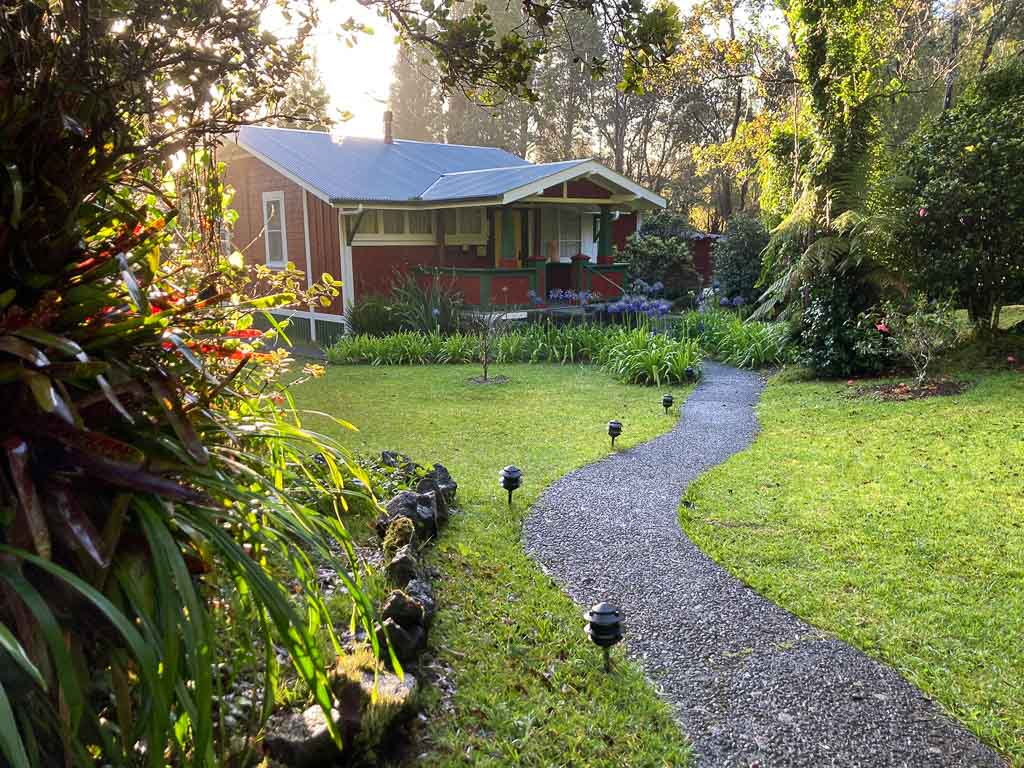
Although it’s not within Hawai‘i Volcanoes National Park, the Volcano Teapot Cottage is only a five-minute drive from the park entrance.
Located in Volcano Village, this is one of the nicest places I’ve ever stayed at near a national park. And it’s definitely a fantastic Hawai’i Volcanoes accommodation option.
The Volcano Teapot Cottage is essentially a private bed and breakfast.
You’ll have the entire place to yourself, while the owners—Bill and Antoinette—restock the kitchen and fridge when you’re out exploring Hawai‘i Volcanoes National Park.
There’ll be freshly cut fruit, breakfast items like eggs, granola, milk and much more, along with pastries.
As its name suggests, the Teapot Cottage is all about tea. There are references to tea all over the place, from art and other décor to books and, of course, countless of varieties of tea in the cupboards and shelves. It’s quite amazing.
There are two bedrooms, a large living room with TV and streaming services, dining area, a great kitchen and a laundry room. The bathroom has a fantastic shower and a clawfoot bathtub.
Additionally, the Volcano Teapot Cottage sits amid a beautiful tropical garden. You’ll wake up to the songs of tropical birds, the scent of the rain forest and sunshine streaming through the drapes. Phenomenal!
I don’t like that I have to say this, but I was not compensated for my stay, nor for this review and recommendation. Just to be clear, this is my opinion only. I just really enjoyed my time at the Volcano Teapot Cottage and want other people to have the same experience when visiting Hawai‘i Volcanoes National Park.
